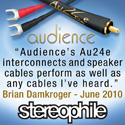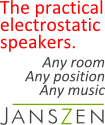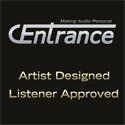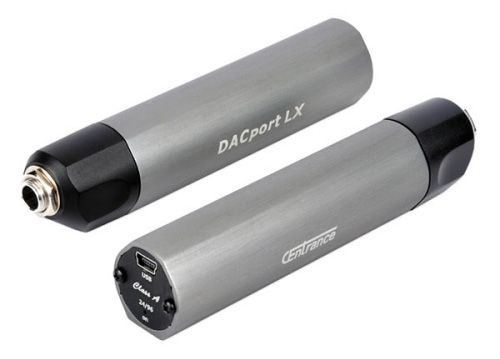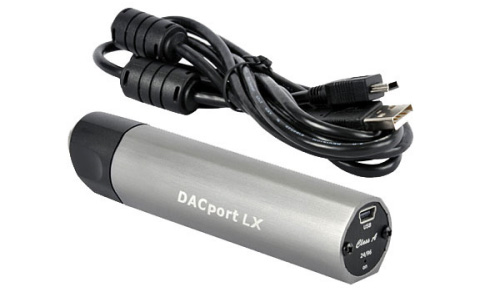|
|
You are reading the older HTML site
Positive Feedback ISSUE 61
centrance DACport LX- A New Reference in Cost-Conscious D to A Conversion as reviewed by Tom Gibbs
Anyone who might have read any of my recent articles here detailing my experiences with creating a low-cost, computer-based audio system has probably picked up on my new mantra, which, distilled into its most basic form is, essentially: Just enjoy the music! And that's basically what I've been doing—not fretting over technical details, not imagining how great things could be if only—I've really, sincerely, been spending a whole lot of time listening to a whole lotta music, and seriously enjoying my system's synergies and surprisingly good performance level. I'm talking about delving into really deep cuts. A lot of stuff that probably hasn't seen the light of day in my system in a really, really long time. It's hard to believe that 18 short months ago, I was listening to the latest 45 rpm releases on the ORG label, and waxing poetically about how it just didn't get any better than this. Those 45 rpm LPs are a spectacular analogue achievement; the Ella Fitzgerald discs in particular offer the kind of realism one rarely encounters in this obsession, but they come at a very high price indeed. Fast forward to now, where I've been waxing rhapsodically for months on end about the latest CD I just acquired for a buck or two. It seems almost too surreal to be true that the two experiences even feign comparison. So when I was contacted about taking a listen to a new budget DAC from CEntrance, I was intrigued... especially at the under-$500 price point where the competition is really beginning to stack up. The name CEntrance did ring a bell. I'd skimmed through a recent Stereophile review of their DACmini CX, but didn't really pay that close attention to it, as it seemed to me to be marketed mostly at Mac owners. A little investigative work turned up a couple of interesting tidbits: CEntrance—whose main market presence has been in the pro-audio gear arena—has been writing code for years for DAC manufacturers as diverse as Benchmark, Bel Canto, Lavry, Mackie, PS Audio and Korg, just to name a few. And the DACmini CX, which retails for less than $800, was just recently given a "Class A" rating on Stereophile's 2012 Recommended Components list. Pretty amazing considering most of the competition in that category have SRPs of $10,000 and up! The original DACport was also included in the Stereophile list with a "Class C" rating, but that unit seemed to be marketed more towards headphone users, and the accompanying review from John Atkinson was mostly directed at its merits as a headphone amplifier. The DACport LX, while maintaining the original's 1/4 inch phone jack connection, is targeted at computer audio users, and is easily hooked up with any number of 1/4 inch-to-stereo adapters. CEntrance's also sent along the premium Reserve Series Interconnect cable to facilitate the review process. It's NOT an Upgrade! OK, so I'm on this whole enjoy the music kick, of which one of the heavy subtexts is strict avoidance of that most dreaded of audiophile afflictions, audiophilus upgradeitus. It requires some seriously staunch discipline for the average audiophile to maintain a consistent level of appreciation for their current system; it's kind of like a 12-step maintenance program, where you constantly avoid entering most audio salons. Partly out of fear of the unknown, but mainly out fear of succumbing to another particularly nasty bug, rapidus creditcarditus, which impairs your ability to communicate effectively the thousand bucks worth of purchases from Dollar Bill's Easy Audio that mysteriously appeared on your latest Visa statement, and you have no recollection (at least, you swear so to your wife!) of how that could have happened, and even worse, you're so anxiety stricken that the best course of action is just to lay low and continue making those incredibly low monthly payments! Hopefully, if you ever reach the twelfth step, you'll have gained the confidence to enter one of those high-end boutiques, turn up your nose and walk out, all the while ultimately still self-convinced of the superiority of your own rig. As I was just about to say, when the CEntrance DACport LX showed up, I quickly realized with the low, low $299 price tag of this little wonder—hey, it's not an upgrade! It's cheaper than my current budget DAC—it might be the least expensive audiophile-quality DAC you'll ever buy. And while it's diminutive size might proffer comments from some about its obvious "budget" lineage, don't allow those already-anticipated size comments (mine's bigger than yours!) to weaken your resolve. The LX offers a surprising amount of heft for such a small package. And while the ultra-swanky (and very nicely constructed) Reserve Series cable ($75) was sent along as a convenience feature, a pretty decent 1/4 inch to stereo adapter can be had from just about any Rat Shack location or music store for a very few bucks—that way you can easily roll your own cable choice if so desired. But in this already low price range, I'd seriously consider springing for the Reserve Series cable—you're gonna be hard pressed to find a more elegant or well-made adapter with the fit and finish this gem brings to the table. A generously-proportioned, well-constructed USB cable is also included for connection to your PC, Mac or Linux device, depending on whatever your particular brand of poison happens to be.
Some Interesting Circuit Choices Michael Goodman is the man behind CEntarnce and some refer to him as a "mad genius"! He's definitely made some interesting choices in his implementation of the digital-to-analog conversion process. Rather than use a mediocre stock USB processor that probably combines the DAC and USB controller on the same chip, they had their own custom chipsets fabricated, separating the USB transfer and DAC functions into discrete circuits for optimal sound quality. The USB chip is centered around a proprietary code they call AdaptiWaveTM, which makes the chip USB class-compliant at 24/96 resolution. That translates into the device not needing any custom drivers, and is universally recognized by Windows, Mac or Linux. CEntrance strongly touts their expertise in circuit miniaturization, and one look inside the case all but confirms that claim—there's a boatload of electronics crammed onto two small circuit boards! But Michael Goodman's most bold decision was to eschew the increasingly popular Asynchronous USB approach—hey, with all the big-name manufacturers he's writing digital code for, it's hard to argue with his results. The DACport uses a circuit that CEntrance calls JitterGuardTM, a dual-stage clock management system that employs buffering to extend a virtually jitter-free signal to the DAC at the conversion point (in the LX, jitter is typically 1ps!). While it is an adaptive transfer protocol, the important thing is to eliminate the jitter, and CEntrance claims the lack of jitter in the LX offers much more natural musical response, with superb definition, increased resolution and an enhanced soundstage presentation. In PC applications, the DACport LX automatically disables the Windows volume slider, which effectively prevents Windows from truncating the bitstream, guaranteeing bit-perfect reproduction—a really nice touch that easily minimizes the user effort usually required to get bit-perfect file streaming. In fact, no drivers are required—the unit is truly plug'n play. And while the DACport can handle all input signals up to 24/96, it also operates in pure, direct-coupled Class A—there are no capacitors in the signal path—pretty impressive for such a low-cost design. Hey, it's also made in the USA—even better! Hooking up the DACport LX is about as simple as it gets – USB into computer, Reserve Series interconnect (or your chosen adapter) into the preamp, then choosing the LX as the output device on both the computer and your music player (J River Media Center – yeah, I know—more to come on this experiment-in-progress soon), and then sending some noise into the device for a day or so to let it burn in a bit. I muted the preamp and turned on the Stanley Cup playoffs for the next four-to-five hours, and decided to then check the LX setup just to confirm that all was well. Just picking up the DACport was a real eye-opener—man, this little baby gets really, really warm, even hotter than my Emotiva XPA-2 amp. Those circuits are definitely cooking in there, what the heck—let's take a listen! Wow! Yeah, yeah, here's where you insert all the typical, "Oh My God!" reviewer clichés—seriously, people, the impact of adding the DACport LX to the playback chain was anything but subtle. What was intended as a brief listen to a few pieces just to get my bearings on where the LX might be taking me tuned into an all-nighter. It was close to 5 am when I finally shut everything down and crawled off to bed. But the DACport didn't just simply enhance my enjoyment of the music; it had me reconfiguring my audio setup before the night was over. I'm basically more of a big-time, old-school analog kind of guy, constantly tweaking speaker positions, etc., trying to achieve that last bit of performance and soundstaging. After a couple of years, I'd pretty much arrived at what I felt was the correct position in the room for my Magneplanars and Def Tech subwoofer, which was about eight feet into the room for the Maggies, less than 12 inches from the sidewalls—quasi-ribbons inward, with maybe a half an inch of toe-in. Sub's in the right corner, behind the Mags. This set up provides a really broad, expansive soundstage, with magnificent imaging and ambience retrieval—sheer perfection for analogue sources. For digital, not so good, I found myself further tweaking the set up to the point where I ended up moving the Mags about a foot further back into the room, six or so inches further away from the sidewalls, with toe-in approaching four-to-six inches. Yes, this is a drastic departure from what I'd previously considered optimal, but it seemed to be the best overall compromise for day-to-day listening, and offered the best balance of sound between large-scale orchestral works and more chamber-oriented and smaller-ensemble works. Insert the DACport LX. First thing I notice is the absolutely articulate, pinpoint imaging. My current DAC is the really good HRT Music Streamer II+, which I still feel offers excellent playback of FLACs, WAVs and such, and is an amazing improvement over digital disc playback via most mid-range CD players. But the DACport LX is on such a completely different level of realism—my brain gears immediately started turning, and in no time, I'd reconfigured the room to the optimal analogue positions—and the sound pouring forth from the speakers was simply glorious! The LX makes my digital playback even more analogue-like than ever before—at this point, it was about 2 am, and I'm seriously about to fall out of my chair, but the sounds coming from the stereo were so very intoxicating! I find my very best listening is really late at night when your brain is so tired, it just stops trying to control everything and pretty much suspends your minds' sensation of disbelief. Sounds become much more palpable and dimensional, and the music just becomes amazing. It's the kind of scenario I try to achieve every time I sit in front of the stereo, but don't always enjoy (liberal portions of various nefarious libations seem to help significantly). But the DACport LX brings you much, much closer to the music! Another effect I immediately honed in on was the really deep, musical and articulate bass being generated with the LX in the system. My Definitive Technology Powerfield subwoofer is old; at least fifteen years (or older), and while it's a great performer for movies and rock music, I'd definitely say it's the weakest link in my system. When it comes to playback of more acoustic-oriented fare, it can be a really delicate tightrope to balance the output level of the sub between divergent musical genres. I generally keep the sub volume knob placed at about ten o'clock, but with the DACport LX in the system, I've been able to crank the sub volume upwards of twelve o'clock or so, which really does wonders for all the rock and full-orchestra classical pieces in my library! I'm easily getting 4-5 additional dB's of output in the bass range—it's really rocking my world! I run the Maggies full-range, and they have plenty of bass for most acoustically oriented music, but integrating a sub can be a real challenge—especially when the music contains a lot of bass content that just demands full volume. That's been the icing on this entire experience; I now get bass that absolutely plumbs the depths and is even more well-integrated with the Maggies than ever before—it's just a win-win situation! I've been looking at new subs for over a year now, and while I still might pull eventually pull the trigger, I'm not in anywhere near the rush! Audio Nirvana Suffers a Minor Glitch OK, so obviously I've been cranking the music much too LOUDLY late at night (note to self: get wife more earplugs), but with the LX in the system, everything just sounds so incredibly unforced and natural—the temptation to crank it is just impossible to resist. Here's where a slight chink in the amour appeared. I began to notice that, in really quiet spaces (especially in jazz and classical music) and in between songs, I could hear hum in the background. And this was not only obvious after playback at ear-splitting levels—even with jazz and more acoustic music at decibel levels between 60-80 dBs, the hum was still apparent. Switch out the LX for the HRT unit and the hum goes away, so it definitely was being generated by the DAC or its associated cabling. After switching interconnects with my own 1/4 inch phone adapter and Audioquest cables, the hum was still there. The LX's USB cabling involves a USB mini connector which I could not duplicate and I thought the USB cable would probably not be the source of the hum, anyway. I promptly contacted CEntrance, who had a new unit sent out that day; unfortunately, when connected to the system, the new unit also hummed quite loudly. At this point I started taking a really good, hard look at all the associated equipment in my room, and within about a week, I finally pinpointed the problem; the DACport LX was picking up RF interference from my ATT wireless internet gateway. It took about an afternoon to recable and reconnect the gateway into an adjacent room in my basement, but voila; the hum was thankfully gone. So while the LX wasn't really generating any hum on its own, it's definitely somewhat susceptible to RF problems—I've had more than one person comment that the 1/4 phone jack could possibly be the culprit. And while the portability of this small wonder is one of the aspects that CEntrance really seems to be pushing, they might want to consider an upgrade to the output connectors (or maybe the shielding) for those who want to keep the unit hard-wired into their audio systems. Additional Listening So far, that only bump has been a minor one, and the couple of weeks of constant burn-in since the DACport LX arrived have only served to improve its already stellar performance. Like I said, I've been listening to a lot of music that's been pretty neglected for quite a while, and it's pretty astonishing how great so much of it sounds through the LX. And I quickly picked up on a very welcome aspect of the DACport LX—it appears to be very forgiving of older and less well-recorded CDs and music sources. It's not a magic bullet by any stretch of the imagination, but it really seems to have a knack for smoothing out some of the rough edges on so many of the CDs languishing in my collection. Just as with less than pristine LPs, there'd alway be a great, classic phono cartridge out there like the Denon DL160 that was much kinder to well worn records, and rarely failed to dig deep and pull a lot of very musical information from those grooves—so the DACport LX is resurrecting so many of my CDs that seem to need help. One of my favorite bands from the eighties and on is XTC and I'm particularly fond of bassist and vocalist Colin Moulding's work with the group. While their LPs tend to sound pretty great, the CDs, especially the domestic Geffen label variety, tend to sound less so great. If you have the opportunity to acquire the remastered imports or the MoFi releases, I'd strongly suggest doing so. Anyway, I've recently picked up several of the domestic releases (at a dollar each, hard to turn down, even with so-so sound), but after ripping them all basically just ignored them. What a surprise to me, then, when I played "Making Plans for Nigel," the opening track on Drums and Wires, to find that it rocked every bit as hard as the LP! And with none of the upper range stridency I'd come to associate with that disc—it sounded nothing short of amazing. I then went for "The Ballad of Peter Pumkinhead" from the eclectic Upsy Daisy Collection, which I mainly bought for the mixture of early hits from LPs I don't currently own. The tune opens with a raspingly distorted guitar figure that rolls into a rollicking drum beat and bass vamp that previously had sounded pretty unlistenable, especially Andy Partridge's vocals about the man who came to town "spreading goodwill and cash around". The vocals were always particularly strident on this disc and everything else was just a mush. Through the DACport LX the sound was urgent and immediate. I've played this song countless times over the last couple of weeks and it's an absolute blast; one that really makes you want to get up and move your feet! The same is true with everything on their classic album English Settlement, which includes so many great and clever songs, and they all bring down the heavy beats. A snooze otherwise, but through the LX.. very magical listening, indeed! I've always been a big prog-rock fan, so when the group Asia burst on the scene in 1981, of course, I was there—I mean, gilded from remnants of Yes, King Crimson and ELP, are you kidding me? I still think their debut album is a prog-transitioning-to-eighties-pop classic, even though I never followed the group beyond that first record. The LP has always sounded pretty good, but the CD has always been thin sounding, with little or no bass and a relatively congested upper register. Now don't get me wrong—there's no miracle taking place here, but through the LX, the bass is greatly improved, the overall sound is way less compressed and John Wetton's vocals are pretty liquid—it just might sound even better than the LP! At least, I was able to make it through all the tracks I played, and actually enjoyed them... which is way more than I could ever say for the CD all these years. One of the CDs I use to help establish good speaker positioning is Japanese violinist Mayuko Kamio's Paganini Caprices, which contains the famous No. 24 that Rachmaninoff's equally famous "Rhapsody" is based on. The CD (on Sony/BMG) is a really superb recording, and through the DACport LX, her violin is dead center in the soundstage, and doesn't sound bloated or abnormally wide, despite the really wide speaker positioning. I have to tell you, people this is almost the sonic equivalent of finding the Grail being able to listen to analogue and digital sources through very finicky speakers, and having them both project rock solid imaging with correct image width and depth—talk about an absolute sound! Another similar experience is through playback of the Anne-Sophie Mutter/Andre Previn disc of Tchaikovsky and Korngold Violin Concertos; whereas through the HRT Music Streamer II+, Anne-Sophie's violin seemed to wander somewhat around the soundstage. Through the LX, she's rock solid and dead center—and this isn't any kind of monoizing the soundstage, she just sounds exactly where she should be. I've actually played this disc so loudly (and cleanly!) through orchestral climaxes, I actually flashed the first row of clipping indicators on the Emotiva XPA2—first time ever! Did I happen to mention I need to get more earplugs for the wife? Another album I play frequently is Natalie Merchant's excellent Tiger Lily; the opening track, "San Andreas Fault" just gets me everytime, with Ms. Merchant's cooing, wordless introduction over electric piano chords that lead to a crashing snare drumbeat that through the MS II+ distorts every time, such that I have to be very careful with the volume level to avoid panel slap on the Maggies. Insert the DACport LX into the system and there is no panel slap at any reasonable volume level (read: anything approaching 12 o'clock). Throught the HRT unit, the panel slaps at just over 9 o'clock—we're probably talking easily about 6 or more dBs in gain, roughly double the SPLs! And don't get me wrong, it's not all about dBs and SPLs here, but life is short and I like to enjoy my music at reference levels. I'm sure Natalie Merchant would approve. Another great CD that has me feeling like a teenager again is the Doobie Brothers' 1974 classic What Were Once Vices are Now Habits, a really great record that through the MS II+ just sounds dated and run-down. Played through the LX, those delicious grooves come back to life, the Doobies had perfected that blend of acoustic/rock/funk that was just irresistible, and hearing this classic music as such takes me back to my San Francisco/Sausalito days when this music was all over the place. Even though "Blackwater" got played to death in the seventies and beyond, hearing it through a really good system is a revelation—it's absolute ear candy. Just last night, I started listening to a trio of classic Clash albums, London Calling into Combat Rock followed by their great, misunderstood classic Sandinista. You know, it's really amazing, the Clash were such a volatile act, seemingly only held together by guitar strings, but jeez, did they make some memorable music, or what! The interplay between Joe Strummer and Mick Jones is so alternating raucous and unbelievably delicate at times, it's really hard to believe they were at each other's throats virtually the whole time. Via the LX, you get the unvarnished truth—these records deserve to be in every collection, played often and loudly. This session drifted into extended time with more heavy hits from the Ramones Mania, a greatest collection that's always sounded less than stellar. This particular version is a test CD from a fad that was all over the ‘net circa 2005 or so. First, you take a CD and convert all the songs to 320 kbps LAME MP3s, then reconvert them to WAVs—supposedly, it resulted in really good sound for albums that suffered from "digititus". I never experienced any real benefit, until now. This disc sounds nothing short of AMAZING via the DACport LX; I think it even betters their vinyl catalog for overall sound quality. Great songs like "Mama's Boy," "Psycho Therapy" and "The KKK Took My Baby Away" have never sounded so good! And so it goes on and on. At my last installment here, I was really sleep depraved and it's even gotten worse, people. When you start getting so used to hearing so much great music, to quote the Doobies: "You just can't stop it!" And what's really bonkers is, as great as the DACport LX is at handling imperfect CDs, the really good ones are off the charts, phenomenally good! Jeez, I'd really love to hear the $800 "Class A" model if this is what you get for only $299! Stereophile "Class C" My Ass! I've got 50 bucks says JA never once even considered unhooking the Sennheisers from his DACport and plugging that puppy into one of those analog big rigs up in Manhattan to let it sing to the masses for a while! Now I've read from several other reviewers around the web who've compared the original DACport's sound to the LX, and they seem to universally agree that removing the amplifier and controls from the original DACport have improved its audio performance significantly. I cannot confirm their conclusions, but neither do I deny them as it makes perfect sense to me. What doesn't make sense is that a component as in-your-face superb as the DACport only rates a Stereophile "Class C" rating! I think they should definitely give the LX a listen to see how it rates strictly on its own merits as a digital-to-analog converter, especially now that it has a much more direct circuit path. In Conclusion You know, I think I may have just given up thinking "things just can't get any better than this"; sure they can. It happens all the time. That's not to say that I'm back on the hunt for the next big improvement. I'll probably just take things as they come in the same way that this splendid little digital-to-analog converter came to me. Digital is on the right path, and with companies like CEntrance blazing the way, that Nirvana we're all looking for is not too far down the road. If you're looking for a remarkably good-sounding USB DAC at a more than reasonable price, I'd look no further than the DACport LX. People are right... this thing's the bomb! Tom Gibbs
DACport LX Digital-to-Analog Converter
Reserve Series Interconnect Cable
CEntrance
|
